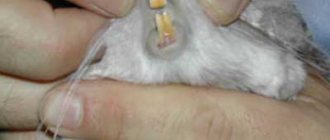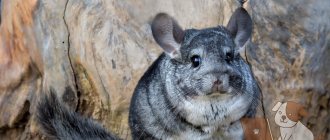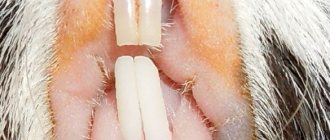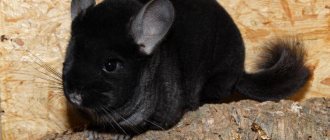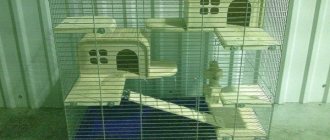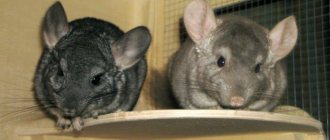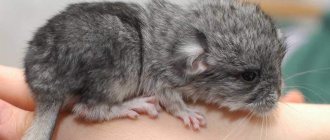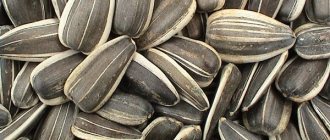Choosing a chinchilla is a responsible task, because it is important that the furry animal becomes a true friend for the whole family. In order for the purchase of an animal to bring only positive emotions, it is important to prepare for this event and follow a number of simple rules when choosing.
- Prepare in advance for the arrival of your pet
. Find out what chinchillas eat, what conditions they live in and how to care for them. Buy a cage and all the necessary accessories. - Decide on the “type” of chinchilla
. One of the most important criteria. The colors of the animals vary widely, so you can make a choice to suit your taste. - Pay attention to behavior
. Phlegmatic people will sit calmly in your arms and look at the world around them, and active choleric people will tirelessly rush around the apartment or cage, storming the wheel. Therefore, you should choose an animal in accordance with your temperament. - Your chinchilla and you must be psychologically compatible
, otherwise you will never become good friends. Take the animal in your arms and wait a few minutes. If he began to study you, for example, climbed onto your shoulders, the animal liked you and very soon you will become friends. But if the animal, having sniffed you, is eager for freedom, this chinchilla is not for you.
Where to buy chinchillas?
Today you can buy a chinchilla in many pet stores, on the market, and also in nurseries. The best option is a professional nursery, because there is a high risk of buying a sick animal on the market. Pet stores also do not provide any guarantees on animals and, once you have paid for your purchase, disclaim all responsibility for live goods.
Therefore, the best option is to contact a nursery that has a positive reputation among lovers of these furry animals. Nursery owners have extensive experience in keeping and breeding chinchillas, and many have veterinary or biological education. From them you can get professional advice on how to care for and what to feed the animal. In addition, in its usual environment, the chinchilla behaves naturally and does not huddle in corners. And in a pet store, the animal usually hides in a corner, fearing noise, the abundance of strangers and bright light.
Let's summarize: the pros and cons of keeping a chinchilla in the house
pros
- does not require regular walks around the apartment;
- clean, does not emit unpleasant odors;
- sleeps a lot, does not require special attention;
- easy to care for, chinchilla does not stink;
- a smart animal, interesting to talk to;
- It is interesting to watch her from the side during activity.
Minuses
- almost impossible to tame;
- makes noise at night;
- may chew on property;
- weak immunity.
Appearance is a reflection of the chinchilla’s psychological and physical health
Regardless of where you decide to purchase a chinchilla, pay attention to the condition of the fur and the general appearance of the furry animal. As a rule, nurseries and pet stores offer only healthy animals, but it is mandatory to examine the future pet before purchasing.
The chinchilla's fur should be dry, clean and shiny. The animal should not have discharge from the nose, eyes or ears, and the skin on the ears and nose should not peel off. A healthy animal's tail should curl upward. The animal should not be sad or lethargic. Make sure that there are no large wounds on the skin, as they usually do not heal well.
Examine other animals living in the same cage. They should have a healthy, cheerful appearance. The cage should be clean, not dirty with a lot of waste. In addition, make sure that there are no signs of indigestion in the cage.
How to choose a chinchilla: a pet with character
So, if you decide to get this cute creature, then when visiting a chinchilla breeder, pay attention to the behavior of the animals when the owner approaches the cages or opens the doors. Keep in mind that each animal has its own unique character. Some of the chinchillas run up to the open door with curiosity and even try to take advantage of the opportunity to get out. These are definitely leaders. They are not only the most active, but also the most restless, and at the same time, the most interesting animals. Communication with them will bring a lot of pleasure and positivity, especially to children.
There is also a type of animal that, when the cage is open, is not in a hurry to leave it, but first tries to find out for what purpose it was opened: whether they want to feed them, offer them a walk, or want to transplant them into another cage. This category of chinchillas has a calm character and balanced temperament. It is good to form long-term pairs from such animals, when the female and the male constantly live together and take care of the offspring.
But there are also chinchillas who either show virtually no reaction when the door is opened, or even try to hide in the farthest corner of the cage. Similar behavior is observed when kept in groups, and these animals are in a depressed state. If you do choose such an animal, then, to be honest, its character is difficult to predict. If the animal is already an adult, it may become withdrawn and avoid contact with humans. If he is still a baby, then perhaps he will grow up to be a cheerful and sociable pet. But if your animal still turns out to be too closed, then in the end, establishing friendly contact with it will depend only on your patience and the time you devote to it.
What gender and age chinchilla should you buy?
Who is better to take - a boy or a girl? It is impossible to answer this question unequivocally, because each chinchilla, regardless of gender, has a unique character. The gender of a chinchilla does not in any way affect the animal's tameability, so choose the animal that you like the most. If you want to buy two pets, choose animals of different sexes.
But age plays an important role. The easiest way to tame a chinchilla is by adopting a baby at 4-5 months. And for breeding it is better to buy a girl at the age of 7-8 months. It is impossible to adopt chinchillas less than two months old, since at this time they still feed on their mother’s milk.
What should you pay attention to when buying a chinchilla?
Choosing a chinchilla is a responsible task, because it is important that the furry animal becomes a true friend for the whole family. In order for the purchase of an animal to bring only positive emotions, it is important to prepare for this event and follow a number of simple rules when choosing.
- Prepare in advance for the arrival of your pet. Find out what chinchillas eat, what conditions they live in and how to care for them. Buy a cage and all the necessary accessories.
- Decide on the “type” of chinchilla. One of the most important criteria. The colors of the animals vary widely, so you can make a choice to suit your taste.
- Pay attention to behavior. Phlegmatic people will sit calmly in your arms and look at the world around them, and active choleric people will tirelessly rush around the apartment or cage, storming the wheel. Therefore, you should choose an animal in accordance with your temperament.
- Your chinchilla and you must be psychologically compatible, otherwise you will never become good friends. Take the animal in your arms and wait a few minutes. If he began to study you, for example, climbed onto your shoulders, the animal liked you and very soon you will become friends. But if the animal, having sniffed you, is eager for freedom, this chinchilla is not for you.
What conditions does a chinchilla need?
Before bringing a furry animal into your home, it is important to create a comfortable living environment for it, bringing it closer to the natural living conditions of chinchillas. It is necessary to buy a cage of sufficient dimensions, bedding, material for a sand bath, and appropriate food. When choosing food, it is better to ask the breeder what the animal was fed so that a sudden change in diet does not cause digestive upset.
When you bring your chinchilla into your home, provide it with peace. After all, the animal suffered enormous stress during transportation, even if the transportation did not last long. During the first 7-8 days, do not let the animal out of the cage and do not forcefully pick it up. Only patience and care will allow you to establish contact with your furry pet and win his affection.
When deciding to buy a chinchilla, it is important to remember that this is a living creature that has its own character, habits and way of life. It is very important to explain to children that the animal should not be “squeezed” or disturbed while resting. Tobacco smoke, drafts and loud music are not good for these animals. If you do not make mistakes in the process of raising and caring for a chinchilla, it can live with you for up to 12-15 years.
Same-sex couples are better pets than singles
If you do not want to have offspring from chinchillas, care for a pregnant female and newborn chinchillas, you can consider the option of creating a same-sex pair. Female sisters or male brothers are ideal for this. They, being relatives, have been together since childhood. A pair can be formed from unrelated females or males if they are mated in childhood. Kids quickly get used to each other and will not conflict when they grow up. In our nursery, chinchillas that have reached the age of 2 months are separated from their mothers into common same-sex groups.
To keep as a pet, we recommend purchasing a pair of same-sex chinchillas. A single pet will experience stress from loneliness, but two chinchillas will play with each other and never get bored.
Information for those who want to buy a chinchilla (recommendations for purchasing and keeping)
My review is very long, but it is a must read for those who want to buy a chinchilla. If you decide to take responsibility for the life of this wonderful animal, do not be lazy to read. So:
1. You should not buy this animal spontaneously, but after the purchase, look for material about its contents. Also, you should not hope that the seller will be able to give you complete information in a few minutes during the sale. Find material about keeping chinchillas on the Internet in advance and ask questions on specialized forums.
2. It is better to buy chinchilla from experienced breeders in specialized nurseries. You should not buy this animal in stores and markets. I also do not recommend taking chinchillas from farms where they are not raised for home keeping. I don’t want to deprive these animals of a chance to find a home. But, if you decide to take a chinchilla in a store or at a Poultry Market, you should know that you may get an adult or a sick animal. On farms, the animal can be wild and difficult to tame. In nurseries where chinchillas are bred for home keeping, you will receive a small and tame cub.
3. Before purchasing a chinchilla, purchase a large, comfortable cage or display case, a convenient carrier, and other things necessary for a chinchilla. If you don't do this in advance, you will have to buy all this at the same time as the chinchilla. And in this case, it may not be available exactly what you would like, and you will have to take what is available. Or the chinchilla will have to wait for some time in uncomfortable conditions until you find and buy something that is suitable. The only thing you don't need to take in advance is food. Along with the chinchilla, you should be given for free or sold exactly the food that it ate, since it is impossible to suddenly switch a chinchilla to another food.
4. The chinchilla should be 3-4 months old when purchased. You should not take a baby that is too small, tearing it away from its mother. And an older chinchilla may be more difficult to tame.
5. If you don't care what color your pet will be, and you are not hunting for a specific color, I advise you to purchase a standard chinchilla. This is the color that a chinchilla has in nature (gray back, white belly). Such animals are cheaper than colored chinchillas, and they have better health.
6. Chinchilla fur is the densest and most hypoallergenic. Therefore, many people are advised to get a chinchilla for people who are allergic to cats and dogs. I want to immediately warn allergy sufferers so that later they don’t have to think about who to give the animal to. Chinchillas must eat hay every day; under no circumstances should a chinchilla be deprived of this. But hay can cause allergic reactions in people with hay fever. Food and special sand for bathing chinchillas can also be dangerous for allergy sufferers, especially if the sand fraction is very fine, in the form of dust or powder. Such sand easily gets into the respiratory tract. Chinchillas themselves cause allergies extremely rarely, but this possibility cannot be ruled out.
7. I do not recommend getting a chinchilla for families with very young or overly active children. Chinchillas should not be squeezed, held in your arms for a long time, chased or played with. However, this cannot be done with any animal. But, if the puppy or kitten remains alive after all this, the chinchilla may die. These are very shy and nervous animals, they can get shock or stroke. Your child must understand how to behave with a chinchilla, otherwise it is better not to get one. In addition, despite the fact that chinchillas are very intelligent and almost never bite, they can still bite if they are hurt or scared. Their incisors are sharp, the bite will be painful.
9. Everything in the cage or display case should be safe. Due to their mobility and activity, chinchillas are susceptible to injury. Therefore, it is necessary to pay very close attention to the issue of safety and carefully consider the placement of all items inside the cage. The distance between the shelves should not be very large, preferably 20-40 cm, since the chinchilla can fall in its sleep or with an unsuccessful jump and be injured. The shelves should overlap each other, that is, they should be positioned in such a way that if a chinchilla falls from the top shelf, it will not fly all the way to the floor, but will land on the nearest shelf. All shelves must be well secured, otherwise the chinchilla may lift the shelf with its head, stick its head through and get stuck. This will result in injury to the chinchilla if it is not released in time. Wooden shelves are preferable to lattice ones. A paw may get stuck in the grill and the chinchilla may break it. For the same reason, ball-shaped hay fields are dangerous. The walls of the cage should be made of metal lattice, not covered with paint, otherwise the chinchilla will chew the paint. Wooden shelves should also not be coated with anything: neither varnish nor paint; you cannot use wood impregnated with different compounds. Heavy ceramic bowls and mineral stones must be well secured or placed on the lower tier, otherwise they may fall off the shelf and crush the animal. Because of its luxurious fur, the chinchilla seems to be a rather large and thick animal, but its bones are very thin and fragile. It is better to place the house on the top shelf. The fact is that the chinchilla feels more confident and calm at the top and prefers to rest there. But in this case, the house also needs to be well secured. It is desirable that the house have not one, but two entrances. This way the chinchilla feels safer and more comfortable, and it will be easier for you to clean the inside of the house, as well as if necessary, get the chinchilla out, for example, if it is hiding in the house due to illness. I do not recommend using fabric hammocks - the chinchilla can chew the fabric and the stomach will become clogged with threads. Better are hammocks made of wooden logs on chains. Of course, if the chinchilla does not chew the hammock and does not pee in it, a rag one is fine. Plastic is not advisable - the chinchilla will chew it too. Materials such as wood (not chipboard), ceramics, and metal are more suitable for arranging a cage. If you have a display case, it should have sufficient ventilation - 2 walls should be made of lattice. The chinchilla should not be in a draft or in open sunlight. But it should be kept in a fairly bright and well-ventilated area. Despite the fact that chinchillas are nocturnal animals, they need daylight for at least a few hours a day. Lack of daylight leads to vitamin D deficiency, which in turn can lead to insufficient absorption of calcium, and, consequently, improper formation of teeth and skeleton. Various aerosols should not be sprayed in the room where the chinchilla lives: polishes, deodorants, household chemicals. You cannot use varnishes and paints. This can result in poisoning of the chinchilla, both sudden and gradual from the cumulative effect.
11. Chinchillas cannot be transported unless absolutely necessary. This is not a cat or a dog that you can, for example, take with you to the dacha. Chinchillas do not tolerate the noise and stuffiness of transport very well. If you still need to take your chinchilla somewhere, for example, to a veterinarian, you need to take it in a car with air conditioning. Air conditioning in a car is a must in the summer, otherwise you risk not transporting your pet.
13. Proper nutrition is very important for a chinchilla. Under no circumstances should chinchillas be fed regular table food, as well as food for other rodents and rabbits. If a chinchilla does not die immediately from such a diet, it will still live less than it would have lived with proper nutrition. But in captivity, a chinchilla can live up to 20 years. And if someone’s chinchilla lived for 7-8 years, that’s very little. Every day, a chinchilla should receive its main food, hay and water. It is advisable to give preference to imported manufacturers, for example, well-established German and Belgian ones. The main feed can be granulated or extruded. The main thing when choosing the main food is to follow the following rules. Firstly, the food must be balanced in terms of protein, fat, carbohydrates, fiber, vitamins and minerals. All standards are available on the Internet on specialized websites. On my own behalf, I will say that it is better to choose food with a high fiber content. The more fiber, the better the chinchilla’s chewing teeth are worn down. Low-fiber food, poor in fiber, is easier to chew, chinchillas are less likely to wear down their chewing teeth, and problems with bite may occur. Secondly, the food should not only be complete and balanced, but uniform. In nature, chinchillas have a very poor diet; their digestive tract is not used to a lot of variety. Therefore, I am against mixing or alternating several different foods. This overloads the chinchilla's gastrointestinal tract. You need to choose one good food and feed it only as the main one. Nowadays there is a wide variety of good and tasty food, and I understand the owner’s desire to pamper his pet with different foods. But you need to pull yourself together and, for the sake of the chinchilla’s health, stick to one food. But softer and tastier foods can only be given as complementary foods in small quantities. If there is a need to switch your chinchilla to a new food, this must be done gradually and very carefully. Every day, in addition to the main food, you also need to give hay. It is not only necessary for proper digestion, but also for regular teeth cleaning. As a treat, you can give dried apple, hawthorn, and rose hips. Many also give raisins, nuts, seeds, and dried banana. I don't give this to my chinchilla. I think that nuts and seeds are too fatty foods for chinchillas, and raisins, dried apricots, and bananas are too sweet. This is harmful to the chinchilla's liver and pancreas. But if you decide to pamper your pet with these treats, give them rarely and in very small quantities. Don't shorten your pet's life. Of course, chinchillas love these treats very much, but do not follow their lead for their own good. Your chinchilla won't be any less happy if he doesn't eat this fatty, sugary food. It’s better to give her a granule of natural bran, a teaspoon of oatmeal, a piece of dried dandelion root, a leaf of dry green or black tea, or hibiscus. Chinchillas love this too. Just don't overdo it with this either. You can give dried leaves of dandelion, nettle, plantain, etc. But do not replace dried leaves with hay. Hay is much coarser and cannot be replaced with anything. I have never and will never give my chinchilla fresh grass and juicy fruits and vegetables. Chinchillas should only eat dried food. Fresh food can lead to tympany. The chinchilla develops gas in the intestines, experiences severe pain and may die. I know that some breeders feed chinchillas fresh or dried grass, as well as fresh fruit. I won’t take any risks and I don’t recommend it to anyone. Also, you should never give your chinchilla animal food, such as insects, eggs, various dairy products (cheese, yogurt, etc.). The chinchilla is a herbivore; its digestive tract is adapted to digest only plant foods. In nature, a chinchilla can sometimes catch an insect, but animal food can harm a domestic chinchilla, even to the point of death. If you think that the chinchilla does not have enough vitamins contained in the food, you can give them additionally in the form of pharmaceutical ones. For example, ascorbic acid or special complex vitamins for rodents. The main thing is not to overdo it. An excess of vitamins is just as harmful as a lack. If you add liquid vitamins to the drinker, change the water often and protect the drinker from the sun, as vitamins oxidize in air and decompose in light. When I add vitamins to the water bottle, I wrap it in black construction paper from a set of children's colored paper and change the water at least once a day.
15. Even a healthy chinchilla needs to be weighed from time to time. A sick chinchilla or a chinchilla with a small weight must be weighed. Because weight loss means health problems and it is better to detect it at an early stage. To do this, you need an electronic kitchen scale with an error of 1 gram. To make the chinchilla sit calmly on the scales, you can give it a piece of dried apple or other tasty treat in its paws. If she doesn’t want to sit on the scales herself, you can put her on the scales in the carrier, not forgetting to then subtract the weight of the carrier by weighing the carrier separately. But I learned to weigh the chinchilla while swimming in the sand. I put the chinchilla bathing suit on the scales. I catch the moment when the chinchilla stops while bathing. (During bathing, the scale readings constantly change due to the chinchilla's movement, but the chinchilla stops from time to time.) And then you can measure the weight. Then I subtract the weight of the bathing suit, weighed separately. This way my chinchilla doesn’t even suspect that he’s being weighed and doesn’t feel stressed. Weight values need to be recorded and monitored so that the weight does not fall. Otherwise, you need to contact a veterinarian.
17. It is very good if you never need the services of a veterinarian. But just in case, it is better to find out in advance the addresses and telephone numbers of clinics where experienced veterinarians who specialize specifically in chinchillas work, as well as where there is a 24-hour call to the doctor’s home or the opportunity to take an x-ray. Not only in case of injuries, but also in case of problems with nutrition, in case of refusal to eat, an x-ray is a mandatory examination. An X-ray of the jaw will show whether there are problems with the teeth. An x-ray of the entire chinchilla will show whether there are problems with the gastrointestinal tract and other internal organs. When diagnosing diseases, ultrasound in such small animals is less informative; x-rays are required.
19. Despite the fact that chinchillas tolerate low air temperatures well, for example, they feel comfortable at a room temperature of 17-18 degrees, they do not tolerate drafts at all. A chinchilla may get a runny nose, which in turn can develop into pneumonia or otitis media. Moreover, in chinchillas such processes occur very quickly, so measures must be taken promptly, without waiting for complications. The veterinarian will need to prescribe treatment, which may require antibiotics. But we must remember that, firstly, antibiotics must be given to chinchillas in the form of injections. It is better not to give antibiotics to chinchillas orally (by mouth), as this disrupts the intestinal microflora. Secondly, chinchillas do not tolerate all antibiotics. You can use, for example, enrofloxacin or baytril. If it is still not possible to give injections, you can give a sumamed suspension. But only the veterinarian decides which antibiotic, in what dosage and for how long to give. Chinchilla injections must be given with an insulin syringe; it has a thinner needle. During the course of antibiotics, it is necessary to give probiotics: beneficial bacteria that inhabit the intestines play a very important role in the digestion of chinchillas. But the microflora can be disrupted even with antibiotic injections. And if a chinchilla takes an antibiotic orally, a probiotic is absolutely necessary. You can give the veterinary drug pro-coline or bifidumbacterin from a human pharmacy. I have no data on whether human infections are transmitted to chinchillas. But, if you yourself are sick, I advise you not to come close to the chinchilla, and certainly not to kiss its nose.
20. A chinchilla must always have in its cage: a mineral stone, a salt stone, and tree branches. Chinchillas chew mineral stone, grinding down their constantly growing incisors, and also replenish the supply of minerals in the body. Chinchillas lick the salt stone, replenishing their salt reserves. Therefore, some owners, seeing that there are no signs of teeth on the salt stone, decide that the chinchilla does not chew the salt stone, and remove it from the cage. There is no need to do this. The salt stone must be kept in the cage at all times. You can notice that a chinchilla is licking it by the slightly shiny surface of the stone; there may not be any traces of incisors on it. The chinchilla gnaws branches to constantly sharpen its incisors, and it can also eat bark. The branches must be thoroughly washed and dried. On the Internet there is a list of tree species that are useful for chinchillas, and there is also a list of those trees whose branches should not be given to chinchillas.
22. Under no circumstances should you put leashes or harnesses designed for rodents or rabbits on your chinchillas. Chinchillas are too jumpy and timid animals, and their fur is too delicate. The use of harnesses is completely unacceptable. There are also walking balls for rodents on sale. I am categorically against using such balls for chinchillas. A chinchilla can overheat in a ball, and no one can claim that a chinchilla experiences positive emotions while walking in a ball. It seems to us that the chinchilla is happily rolling around in a ball on the floor, but in fact she is trying to escape from the ball and does not understand what is happening. It is better to install a wheel in the cage. But, firstly, the wheel for a chinchilla must be large - at least 32 cm. Otherwise, the chinchilla will arch its back and bend its spine. And, secondly, the wheel must be safe, preferably wooden with a closed wall, and not a metal lattice without a side wall. In such a wheel, the tail and paws of the animal can be damaged. Even better and safer is a treadmill. But not all chinchillas run in it. They probably won’t immediately understand how to run in it.
23. Under no circumstances should chinchillas be walked outside or in nature. I'm not even talking about the fact that a chinchilla can run away, get severe stress, injury, overheat or catch a cold, or be attacked by dogs and other animals. She may also get an infection, intestinal parasites, or shingles. One short walk can cost a chinchilla its life or lead to long-term, expensive treatment. By the way, no vaccinations can be given to chinchillas.
25. I do not recommend getting chinchillas if there is already another pet in the house: a dog, cat or other predator. Even if it seems to you that they get along well: they play, sleep together, this does not mean at all that sooner or later the predator instinct will not work. And your cat or dog will not bite the chinchilla or crush it with its paw. Just while playing, a larger animal may not be able to control itself and accidentally injure the chinchilla. And even if you constantly keep the chinchilla in a cage, and another animal lies nearby and calmly watches it, the chinchilla will experience stress. You may not notice it: your chinchilla won't thrash, scream, or act strangely, but that doesn't mean she isn't stressed.
26. If a chinchilla has suffered an injury to its paw or tail, you must not only show it to a veterinarian and carry out treatment, but also make sure that the chinchilla does not chew on the injured limb. Chinchillas, like other rodents, have the peculiarity of gnawing off a sore limb, which causes pain and inconvenience. Therefore, you may need a special restrictive neck collar, which you can make yourself from a plastic bottle or find a collar of a suitable diameter in pet stores.
27. A healthy chinchilla's teeth should be orange. Only small chinchillas can have yellow teeth, but over time they should turn orange. If your chinchilla has white teeth, you need to give her calcium supplements, as well as vitamin C.
28. Chinchillas don't shed seasonally, but that doesn't mean they don't shed at all. Chinchillas' fur is constantly renewed. If the room is very warm, the fur may grow noticeably; this is a natural protective reaction to rising temperatures. In a cool room, this process is less intense, so that shedding is almost invisible. If you look closely, you will notice that on one of the toes of chinchillas' hind legs the fur is stiffer, almost like bristles. Chinchillas use this bristle to comb their fur like a brush.
29. Chinchillas are routine animals. They very quickly get used to the routine and monotony of life. If you put out a bath with sand, give a treat from your hands, let him walk around the room and clean the cage at the same time every time, the chinchilla will get used to it very quickly. Compliance with the regime has a very good effect on the health of the chinchilla, but remember that there is one drawback to the regime. If you ever fail to do something at a certain time, your chinchilla will wait and get nervous. Therefore, if you are not sure that you can constantly adhere to the regime, it is better not to accustom your chinchilla to this.
31. I may have missed some important points, but the Internet exists and you can find the information you need there. The main thing is to find it in advance, and not when it’s too late. If you are not ready to spend enough money and time on keeping a chinchilla, don’t get one, don’t. Do not condemn this wonderful, gentle and touching animal to an unhappy and short life. A chinchilla is not an animal that can live just like that, without much effort on your part. But if you create all the conditions for a comfortable life and are gentle and patient, the chinchilla will respond to you with love. She will trust you and give you long and pleasant communication. Just scratching a chinchilla behind the ear is worth it.
My reviews about products for chinchillas:
altarona recommends Chinchilla / Chinchilla
5.Chompers:
Dental care is essential for chinchillas because their teeth (like most members of the rodent family) are constantly growing. If you notice that your pet is eating less or suddenly stops eating all together, it is recommended that you make an appointment with your veterinarian for a consultation. Chew toys are a great way to maintain oral health. The best chew options are wooden fruit tree branches, wooden chew blocks, and lava chew toys. Timothy or grass hay also helps wear down ever-growing teeth and is a vital part of your chinchilla's nutrition and care.
Teeth trimming
Although this article was focused on chinchillas, I hope it helps everyone understand the amount of research and questions to ask before introducing a new pet into your life and home. Remember to always do your homework, but also be aware of your veterinary team or check out College Manor Vert Hospital - they are a great resource with a wealth of knowledge and past experience to share. We're just waiting to be asked!
How long do chinchillas live?
Many people are very surprised when they find out that domestic chinchillas. Chinchillas are a rodent from the chinchilla family that looks like something in between. They live longer than cats and dogs. It is believed that in the wild, a chinchilla is a rodent from the chinchilla family, outwardly similar to something average... on average, it lives up to 6-7 years, with a maximum of 10. But this is under constant threat of hunger, cold, predators and poachers.
If we talk about the maximum life expectancy of chinchillas at home, then the results are completely different. Of course, a lot depends on how well the owner takes care of the animal, and also, in some cases, on the breed of chinchillas. But on average, these animals live up to 15-20 years. Also, a certain percentage reaches the age of 25 years. Some sources claim that some individuals even overcome the 30-year mark.
WHAT YOU NEED TO KNOW BEFORE BUYING A CHINCHILLA
1) The optimal temperature in the room where the chinchilla is kept is 10-25 C. At temperatures above 25 C the animal feels unwell, and above 30 C it dies. Therefore, it is recommended to purchase an air conditioner.
2) Chinchillas are “afraid” of drafts. Consider this point when walking and when choosing a place for the cage, installing an air conditioner or fan.
3) The chinchilla is a rodent and on a walk it tastes everything, be it wires, wallpaper, flowers. Therefore, it is recommended to cover wires and remove flowers, especially poisonous ones.
4) Chinchillas reproduce in pairs. And even if a different-sex couple spent 1.5-2 years without children, it does not mean that in six months or a year she will not present you with a surprise in the form of 1-3 curious lumps.
5) The chinchilla is a very clean animal. Her urine and boluses (litter) do not smell. It is enough to remove sawdust/filler 1-2 times a week and there will be no smell at all.
6) Chinchillas are wonderful companions.
7) Chinchillas bathe in sand/dust.
 You should only bathe a chinchilla in water as a last resort. If such a need arises, dry the animal thoroughly so that it does not catch a cold.
You should only bathe a chinchilla in water as a last resort. If such a need arises, dry the animal thoroughly so that it does not catch a cold.
9) Chinchillas are very curious and active, they like to get underfoot. Keep this in mind as you walk.
10) Chinchillas are crepuscular animals, the greatest activity occurs in the early morning and late evening, sometimes at night. At this time they like to run around and sometimes rattle their bowl :) This feature should be taken into account when choosing a place. For this reason, it is not recommended to place the cage in the bedroom.
11) Chinchillas are very active and restless animals. Don't expect the animal to sit quietly in your arms for a long time.
